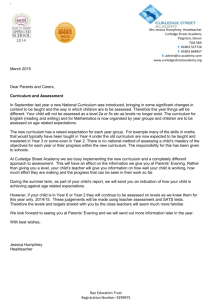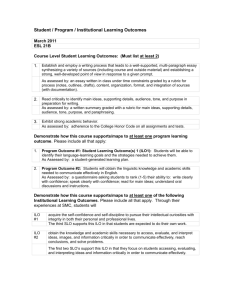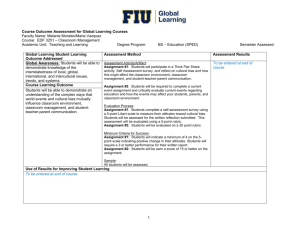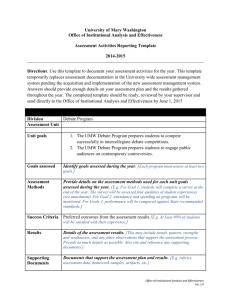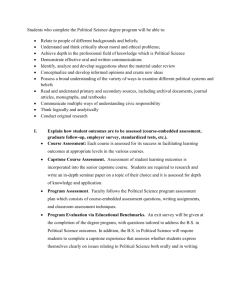animal husbandry (alt a)
advertisement
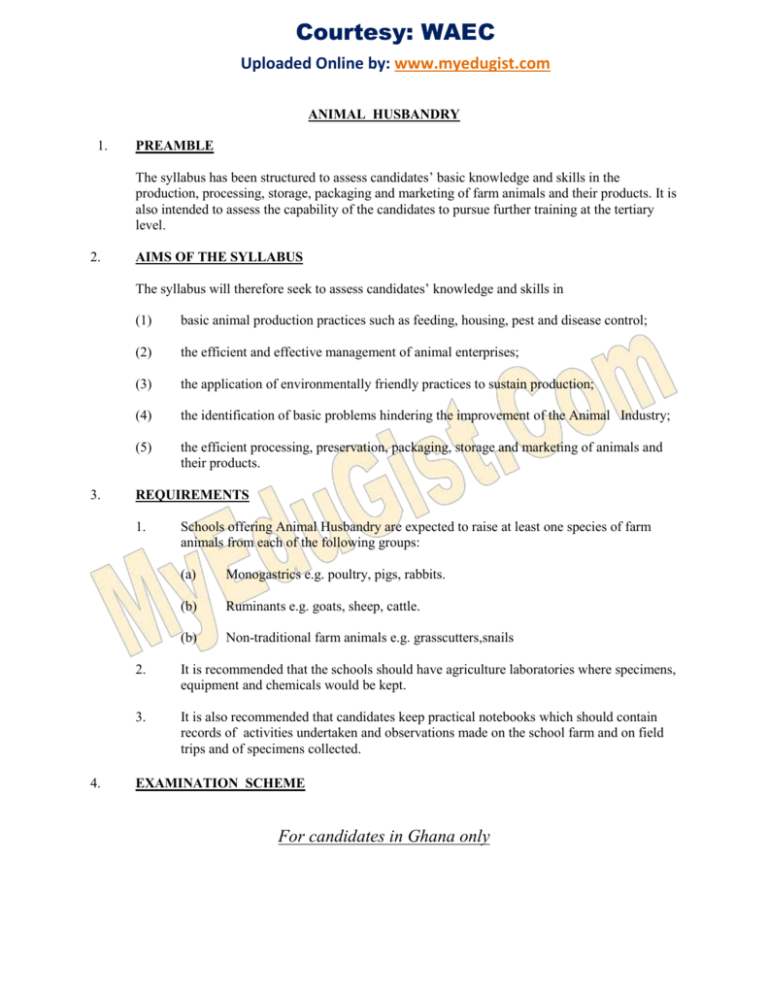
Courtesy: WAEC Uploaded Online by: www.myedugist.com ANIMAL HUSBANDRY 1. PREAMBLE The syllabus has been structured to assess candidates’ basic knowledge and skills in the production, processing, storage, packaging and marketing of farm animals and their products. It is also intended to assess the capability of the candidates to pursue further training at the tertiary level. 2. AIMS OF THE SYLLABUS The syllabus will therefore seek to assess candidates’ knowledge and skills in 3. (1) basic animal production practices such as feeding, housing, pest and disease control; (2) the efficient and effective management of animal enterprises; (3) the application of environmentally friendly practices to sustain production; (4) the identification of basic problems hindering the improvement of the Animal Industry; (5) the efficient processing, preservation, packaging, storage and marketing of animals and their products. REQUIREMENTS 1. 4. Schools offering Animal Husbandry are expected to raise at least one species of farm animals from each of the following groups: (a) Monogastrics e.g. poultry, pigs, rabbits. (b) Ruminants e.g. goats, sheep, cattle. (b) Non-traditional farm animals e.g. grasscutters,snails 2. It is recommended that the schools should have agriculture laboratories where specimens, equipment and chemicals would be kept. 3. It is also recommended that candidates keep practical notebooks which should contain records of activities undertaken and observations made on the school farm and on field trips and of specimens collected. EXAMINATION SCHEME For candidates in Ghana only Uploaded Online by: www.myedugist.com There will be three papers, Papers 1, 2 and 3, all of which must be taken. Papers 1 and 2 will be a composite paper to be taken at one sitting. PAPER 1: Will consist of fifty multiple choice objective questions all of which must be answered within 1 hour for 50 marks. PAPER 2: Will consist of six essay-type questions. Candidates will be required to answer four questions within 2 hours for 80 marks. PAPER 3: Will be a practical paper for school candidates or a test of practical paper for private candidates. The paper will consist of four questions all of which must be answered within 2 hours for 60 marks. CONTENTS NOTES A. INTRODUCTION TO ANIMAL HUSBANDRY 1. Meaning, scope and importance of animal husbandry Knowledge of the meaning (rearing of farm animals), scope (nutrition, health, etc.) and importance (source of food, employment, income, etc) of farm animals are required. 2. Problems in animal production Knowledge and understanding of the problems in animal production in West Africa and possible solutions to the problems will be assessed. 3.Quality and Safety standard of animal food products Description of the quality and safety standards of animal food products. Practices for maintaining standards, effect of consuming poor animal products and roles of agencies involved in the animal food products safety and quality will be assessed. 4. Classification of farm animals Classification based on; 1. Digestive system (a) Ruminants e.g. sheep, goat, cattle (b) Non-ruminants (monogastrics) eg. poultry, pigs (c) Non-ruminant herbivores e.g. rabbits, grasscutter, guinea pigs. 2. Concept of traditional (cattle, sheep, goat) and non-traditional farmanimals (rabbit, grasscutter, snails). B. ANATOMY AND PHYSIOLOGY OF FARM ANIMALS 1. Meaning of the terms: anatomy, physiology and the external orientation of farm animals 2. Digestive System (a) Comparative anatomy of digestive system of farm animals (b) Digestion and Absorption processes in the various classes of farm animals 3. Central Nervous System (a) Parts of the Central Nervous System (CNS) and Autonomic Nervous System (ANS) (b) Functions of the ANS Understanding of the terms anatomy and physiology; and knowledge of parts and positions of the various external parts (orientation) of farm animals e.g. the head of the cow is anterior to the hind limb or udder; will be assessed. The main features of the digestive systems of ruminants, non-ruminant herbivores and monogastrics and the differences in structure and functions will be assessed. Candidates’ understanding of digestion processes in the various classes of farm animals, the role of specific enzymes in the digestion of specific nutrients e.g. carbohydrates, proteins, fats and oils in farm animals, and the structures and processes involved in absorption of nutrients will be assessed. Ability to identify the parts of the CNS and ANS and describe the mode of action of the CNS and ANS is required. Knowledge of the functions of the ANS is required. The ability to explain how nerve impulses are transmitted and how homeostasis is ensured will also be assessed. Knowledge of what endocrine glands are, their location in the body and functions will be assessed. (c) Endocrine System (i) Endocrine glands and their functions (ii) Hormones and their functions 4. Integumentary, skeletal and muscular systems 5. Reproductive System (a) Anatomy of the reproductive system of poultry and livestock (b) Functions of organs and parts of the reproductive system (c) Reproductive processes 6. Circulatory System (a) Structure and functions (b) Heart and Pulse Hormones, their functions and mode of action, and understanding of the need to administer synthetic hormones will be assessed The structure and functions of the integumentary (skin), skeletal and muscular systems will be assessed. Understanding of reproductive terms e.g. puberty, oestrous cycle, oestrus/anoestrus, ovulation, fertilization, libido, etc will be assessed. Knowledge of the main features of the reproductive system of poultry and livestock will be assessed. Knowledge of the functions of the organs and parts of the reproductive system will be assessed. The various stages in the reproductive process (from puberty through mating to parturition); differences between the reproductive processes in poultry and livestock will be assessed. Knowledge of reproductive hormones and their functions is also required. Assessment will be on the various organs of the system e.g. heart, blood vessels; tissues (blood, lymph) and cells (blood cells); and their functions. Differences between pulmonary and systemic circulation will also be assessed. Meaning of heart and pulse rate and the interpretation of their values will be rate 7. Respiratory System (a) Meaning and Importance of Respiration (b) Structure and Functions of the Respiratory System 8. Excretory System (a) Meaning and Importance of the Excretion assessed. Understanding of the term respiration and its importance will be assessed. The structure and functions of the parts of the respiratory system of livestock will be required. Understanding of the term excretion and its importance is required (b) Structure and Functions of the Excretory System The structure and functions of the parts of the excretory system of livestock will be required. (c) Excretory Products Examples of excretory products and how they are eliminated from the body is required. C. ANIMAL NUTRITION 1. Introduction to Animal Nutrition (a) Meaning and Importance Understanding of the term nutrition and its importance/role in animal production e.g. improves body resistance, production level, etc. will be assessed. Understanding of basic nutrition terms such as nutrients, diet, ration, roughages, malnutrition, concentrates, etc will also be required. (b) Modes of feeding 2. Feedstuffs and Feed Supplements The differences in the various modes of feeding in non-ruminant herbivores, ruminants, carnivores and omnivores will be required. The influence of the type of dentition on the mode of feeding of the animals will also be required. (a) Types, composition and functions of the feed nutrients (b) Classification of feedstuffs (c) Food tests (d) Producers and suppliers of feedstuffs and supplements 3. Formulation and Preparation of Animal Feeds (a) Common terms used in feed formulation Feedstuffs and supplements, their main composition and functions of the major nutrients will be required Ability to group feedstuffs according to the major nutrients they supply will also be assessed. Ability to use simple food tests to detect the presence of carbohydrates, fats and oils, proteins in feedstuffs is required. Knowledge of major producers and suppliers of feedstuffs in the country is also required Understanding of the common terms used in formulation such as dry matter, diet, metabolizable energy, malnutrition etc. will be assessed. (b) Factors considered in the formulation of ration Factors considered in the formulation of rations e.g. age, physiological state of the animal, cost of feed ingredients etc. will be required. (c) Steps in the formulation of ration Ability to use the Pearson Square Method to formulate a balanced ration is required. 4. Handling and Storage of Animal Feeds (a) Importance of feed storage and features of storage structures Importance of feed storage and features of the various feed storage structures/containers will be required. (b) Factors that affect the quality of stored feed Factors which affect the quality of stored feed e.g. storage temperature/ambient temperature, humidity, water content, pests and rodents will be required. Ability to follow procedures /practices in the handling of stored feed e.g. drying, fumigation, will also be assessed. 5. Record keeping and estimation of cost of prepared feed 6. Pests of stored feed and their control D. ANIMAL HEALTH Ability to keep feed records and estimate the cost of prepared feed will be assessed. Ability to identify common pests of stored feeds, the effects of pests on stored feed (e.g. damage, contamination), preventive and control measures of pests in feed will be assessed. 1. Meaning of terms Candidates will be assessed on their understanding of the terms: disease, pest and parasite. 2. Signs of good and illhealth Knowledge of the characteristics of healthy and sick animals and ability to describe the signs and symptoms of disease in farm animals will be assessed. 3. Factors that predispose animals to diseases Understanding of the factors and how they predispose animals to diseases e.g. over crowding, poor nutrition, poor housing, Causes of stress and measures to reduce stress in farm animals will be assessed. 4. Effects of diseases, pests and parasites on animal production Understanding of the effects of diseases, pests and parasites on the economic value of animals/ animal products and income e.g. reduced value/output, loss of income, reduced quality of products, will be assessed. 5. Zoonotic diseases; their importance and prevention Understanding of the term zoonotic disease and its importance e.g. effect on human health and preventive methods will be assessed. 6. Pathogens of farm animal diseases Knowledge of the various classes of (a) Classification of pathogens (b) Pathogenic diseases and their economic importance (c) Principles for prevention and control of diseases of farm animals (d) Management practices in the prevention and control of diseases of farm animals pathogens (viruses, bacteria, fungi and protozoa) Common pathogenic diseases and their economic importance in animal production will be assessed. Principles for prevention and control of diseases (e.g. nutrition, vaccination, ) with respect to cost, suitability and efficiency; Ability to use prophylactics (coccidiostat, anti-biotics, anti-stress drugs, vitamins) to control animal diseases will be assessed. Practices such as deworming, dipping, dusting, treatment of wounds and sores, spraying and fumigation of animal houses, drug administration and precautions to be taken in the use of drugs for disease control will be assessed. 7. Ectoparasites and endoparasites (a) Types and examples of parasites (b) Structure, life cycle and mode of feeding (c) Conditions that influence parasite population 8. Prevention and control of parasites Knowledge of the two main types of parasites (ecto and endoparasites) and examples is required. The structure, life cycle and mode of feeding of the common types of endoand ectoparasites will be required. Conditions that affect parasite population, and how they could be changed to reduce parasite population will be assessed. Measures such as deworming, drenching, dipping, farm sanitation etc, the use of appropriate equipment and chemicals in the prevention and control of parasites will be assessed. 9. Economic importance of parasites The economic importance of ectoparasites and endoparasites (i) on the host e.g. ectoparasites damage skin and hides, suck blood. Endoparasites damage internal organs (ii) on animal products e.g. loss of income, increased expenditure due to control measures, etc. will be assessed. E. GENETIC PRINCIPLES AND ANIMAL IMPROVEMENT 1. Heredity, basic genetic terms and Mendel’s first law of inheritance Candidates will be assessed on their understanding of heredity and associated genetic terms (e.g. gene, genotype, phenotype, sex-linkage) in animals, the processes of cell division (meiosis and mitosis) and inheritance of traits; Mendel’s first law of inheritance of genes 2. Meaning, objectives and benefits of animal improvement Understanding of the term animal improvement and knowledge of the objectives and benefits of animal improvement e.g. disease resistance, better growth rate, will be assessed. 3. Performance traits of improved and unimproved animals Ability to analyze data to determine superiority of improved animals based on genotype and phenotype will be assessed. 4. Methods of animal improvement; advantages and disadvantages The different methods of animal improvement (introduction, selection, breeding), types of breeding (e.g. cross breeding, line breeding), advantages and disadvantages of the different methods of animal improvement will be required. 5. Nutritional and environmental factors affecting animal improvement Nutritional and environmental factors that affect animal improvement will be assessed 6. Artificial Insemination (a) Meaning and process of artificial insemination (A.I.) (b) Advantages of A.I. (c) Signs of heat (oestrus) and handling procedures in the collection and storage of semen F. INTRODUCTION TO ENVIRONMENTAL PHYSIOLOGY 1. Internal and external environment of animals 2. The role of the nervous and endocrine systems in homeostasis and animal’s response to stimuli Understanding of the term artificial insemination, the ability to describe A.I. technique and name of tools and equipment used in the process are required. Advantages in the use of A.I. will be required. Ability to detect heat in farm animals through knowledge of signs of heat and the proper handling procedures in the collection and storage of semen will be assessed Candidates will be assessed on what constitutes the internal environment (e.g. blood glucose level, body temperature) and external environment (e.g. ambient temperature, humidity, wind) of animals and examples of acceptable levels of constituents of these environments The role of the nervous and endocrine systems in creating environmental awareness in animals, their responses to stimuli and maintenance of homeostasis e.g. normal levels of body Temperature espiration; heart rate is required. Knowledge of physiological and behavioural responses of animals to heat, cold, exercise, etc is also required. 3. Determination of room Knowledge of equipment employed in the measurement of temperature, temperature, body temperature and respiration rate in farm animals 4. Effects of climate on farm animals humidity, respiration rate, heart beat, etc. and the ability to use the equipment and interpretation of generated data are required Indirect and direct effects of climate on farm animals (e.g. disease prevalence, feed quality and quantity, heat stress, increased abortion) will be assessed. Understanding of the terms thermoneutral zone and optimum temperature and their relation to animal productivity will be assessed. 5. Modification of animal environment and management pratices to reduce stress on animals Ways of modifying the environment e.g. provision of appropriate housing, shading, cooling; and management (e.g. better feeding, time of grazing, etc.) on improved animal productivity will be assessed. Strategies to minimize stress e.g. design and lay-out of houses, provision of cool water, modified feeds, proper timing of drug administration will also be assessed. G. MONOGASTRIC AND DOMESTIC PET PRODUCTION 1. Poultry production (a) Definition and characteristics of poultry (b) Classes of poultry (c) Breeds and types of poultry Candidates will be assessed on their understanding of the term poultry and knowledge of the characteristics of poultry e.g. possession of beaks, wings, feathers. Knowledge of the different types of poultry e.g. chicken, turkey, ducks, Guinea fowls and ostriches will be assessed. Knowledge of the breeds of the various types of poultry: Chicken e.g Rhode Island Red, Plymouth Rock; Guinea fowl e.g.Grey, Red-wattled (Pearl variety); Turkey e.g. Broad Breasted Bronze: Ducks e.g. Muscovy, Khaki Campbell; Ostriches e.g. Blue Neck, Red Neck will be assessed. (d) Importance/role of poultry production (e) Systems of poultry Production (f) Incubation and Hatchery Practices (i) Terminologies The importance of the production of the various types of poultry will be assessed. The various systems of poultry keeping and the advantages and disadvantages of the various production systems: extensive, intensive, semi-intensive systems will be required. Understanding of terms such as fertile egg, hatchability, incubation and broodiness will be assessed. (ii) Natural and Artificial Incubation Ability to describe and differentiate between natural and artificial incubation, the advantages and disadvantages of each method of incubation will be assessed. (iii) Selection of eggs for Hatching Knowledge of the characteristics of eggs suitable for hatching and the ability to select them for hatching are required. (iv) Conditions necessary for hatching of eggs Knowledge of the incubation period of the types of poultry and the conditions necessary for hatching of eggs will be assessed. (v) Incubation Process Ability to describe the process of incubation and knowledge of hatchery practices that would ensure production of healthy chicks e.g. fumigation, temperature will be assessed. (vi) Candling of Eggs Understanding of the process of candling of eggs is required. (vii) Marketing of dayold chicks Techniques and precautions for the marketing of day-old chicks will be assessed. (g) Management Practices Management practices i.e. housing, breeding, brooding, feeding, sanitation, pest and disease control, identification, record keeping, etc. will be assessed. (h) Processing and marketing of Poultry Knowledge and understanding of the activities involved in the processing and marketing of poultry i.e. slaughtering and Processing, Quality Control, Packaging, Preservation and Storage, Marketing Outlets, transportation and advertisement will be assessed. (i) Prospects of producing the various types of poultry The prospects for keeping the various types of poultry, consumer preferences, market availability, cost etc will be assessed. 2. Pig Production (a) Types, breeds and characteristics Candidates will be assessed on their knowledge of (i) Types of pig. i.e. bacon, lard and pork types (ii) Breeds of pig e.g., Yorkshire, Ashanti Black, Large White, Landrace, and (iii) The characteristics of the breeds of pig. The importance of pig production to the economy i.e. source of employment, income, insulin used in pharmaceutical industries etc will be assessed. (b) Importance of pig production (c) Systems of keeping pigs Candidates’ understanding of and ability to describe the various management systems of pig production i.e. Intensive, Semi-intensive and Extensive systems will be assessed. The advantages and disadvantages of each of the management systems will also be assessed. (d) Management practices The various management practices used in pig production e.g. breeding, housing amd feeding will be assessed. (e) Slaughtering, processing and marketing of pigs Knowledge and techniques of slaughtering, processing and marketing practices, e.g. bacon making, quality control, packaging, storage, identification of marketing outlets, advertisements etc. will be assessed. 3. Domestic Pets (a) Meaning and Importance of pets The meaning of the term ‘pet’; (e.g. cat, dog, parrot) and the important roles pets play in the society e.g. security, income, shepherding, companionship are required. (b) Management of pets The management practices in the raising of pets such as housing, feeding, sanitation, breeding, grooming and care, pests and diseases and their control will be assessed. The importance of pet licencing and regular vaccination will be assessed. (c) Training of Pets Knowledge of animal behaviour and reasons for training of pets is required. (d) Marketing of pets Marketing strategies and value chain process in the marketing of pets will be assessed. (H) RUMINANT PRODUCTION 1. Sheep and goat production. (a) Common Breeds, Distribution and Characteristics The common breeds of sheep and goats and their geographical distribution will be assessed. The distinguishing features between sheep and goats, as well as the characteristics of the breeds e.g. body size, nature of hair cover and horn shape will also be assessed. (b) Importance of sheep and goats (c) Management Practices (d) Common parasites and diseases and their control (e) Processing and marketing The importance of sheep and goats i.e. Social e.g. religious; Economic e.g. income, hides and skin for leather etc; Nutrition e.g. meat for food etc. is required. Production requirements using a value chain approach is required. Management practices in the production of sheep and goats such as hoof trimming, housing, feeding, sanitation, disease and pest control are also required. Ability to determine the age of sheep and goat by the dentition will be assessed. Common parasites (ticks and worms) and diseases of sheep and goats e.g anthrax, mastitis, foot rot; signs/symptoms of infection and control measures will be assessed. Techniques involved in the processing and marketing of sheep and goats to ensure meat quality, safety and consumer satisfaction including slaughtering and processing, quality control, preservation and storage, packaging, advertising and marketing outlets will be assessed. 2. Beef Cattle Production (a) Breeds and characteristics Common breeds of beef cattle in West Africa and Europe; and the characteristics and general structure of breef breeds will be assessed. (b) Importance of beef cattle production The importance of beef cattle production i.e. nutritional value of beef, use of hides, horns, bones and manure, social and economic value of beef and live cattle will be assessed. (c) Common Production Systems The common production systems of beef cattle e.g. Extensive, pastoral, agropastoral, semi-intensive, intensive feedlot,pastures), their characteristics and the strengths and weaknesses of each system will be assessed. (d) Planning,production and management of cattle for beef and traction The requirements, using value chain approach for producing beef cattle; selection of management system, foundation stock, and qualities of bulls and cows to be selected for traction will be assessed. e) General management practices Skills in carrying out practices such as housing, feeding, breeding, fattening, etc. Knowledge of training of yoked cattle will be assessed. (f) Processing and marketing Techniques of slaughtering and processing of carcass, maintenance of safety standards, packaging and sale of meat products will be assessed. (g) Major Problems in beef cattle production 3. Dairy cattle production (a) Breeds and features of dairy cow (b) Characteristics, sources and importance of milk The negative effects of poor management of beef cattle on the environment, as well as problems of feed and water shortages, cattle theft ,pestsetc and their solutions will be assessed. . Examples of pure and cross bred dairy breeds in tropical and temperate regions; and the distinguishing features of dairy cow will be assessed. Knowledge of the composition and nutritional value of fresh milk will be assessed. Knowledge of sources of milk such as goats, sheep, buffaloes, camels and cattle and the importance of milk from dairy cattle including food, income,employment, trade etc. will be assessed. c) Management practices (d) Diseases and their control (e) Production, processing and marketing of milk and dairy products (f) Problems of dairy cattle production in warm climates I. RANGE AND PASTURE MANAGEMENT 1. Introduction to range and pastures (a) Basic terminologies in pasture and range management The requirements, using a value chain approach, for producing milk from dairy cattle e.g. market demand for milk and dairy products, inputs for producing wholesome /healthy milk etc. Selecting suitable breeds and management systems will be assessed. Knowledge of symptoms and methods of controlling mastitis, tuberculosis and ketosis is required. Equipment and tools required for milking, milk handling and processing; pasteurization of milk; examples of products e.g. yoghurt, cottage cheese, tinned milk, powdered milk will be assessed. (i) Knowledge of consequences of consuming contaminated milk will be assessed. (ii) Knowledge in maintaining quality and safety standards in milk processing and marketing will be assessed. Knowledge of packaging,storage and marketing practices will also be assessed. Effects of warm climate on dairy animals and milk production; and the solutions to the problems will be assessed. Candidates will be assessed on their understanding of the basic terms in pasture and range management e.g. pasture, pasture rotation, stocking rate, range, forage crops Types of pasture (natural/range and artificial/cultivated) and their features will be assessed. (b) Types of pasture and their features (c) Importance of pastures and forage The role of forage and pasture crops in animal production will be assessed. crops in animal production (d) Factors that affect the productivity of different types of pasture (e) Major forage crops (f) Poisonous plants in pasture The factors that affect the productivity of different types of pasture eg. rainfall, soil fertility, temperature, weeds, etc. is required Knowledge of the common and scientific names of the major forage crops and their classification are required. Knowledge of poisonous plants in pasture e.g. Lantana camara, Crotalaria rotundusis required. 2. Pasture establishment and management (a) Qualities of good pasture and forage species (b) Establishment of pasture (c) Improving natural Pastures (d) Management of cultivated pastures (e) Harvesting of forage crops 3. Forage conservation Knowledge of qualitites of good pasture and forage species e.g. high productivity, palatability and fast growth is required. Cultural practices associated with pasture establishment e.g. site selection, land preparation, methods of propagation of pasture, their merits and demerits, i.e. seeding, vegetative means will be assessed. Understanding of the need to improve natural pastures and the techniques for improving natural pastures will be required. Skills in managing cultivated pastures e.g. control of fire, proper stocking rate, disease prevention and control will be assessed. Knowledge of tools/equipment for harvesting forage crops and yield determination will be assessed. and utilization (a) Forage conservation and its importance (b) Preparation of hay and silage (c) Utilization of crop residue in feeding animals Forage conservation and its importance; the various forms of conserved forage e.g. hay and silage; and differences between hay and silage based on the physical,chemical and nutritive properties will be assessed The processes and precautions in the preparation of hay and silage e.g. cutting herbage at the right time, proper compacting, use of additives,etc will be assessed. The different types of crop residue, the merits and demerits of using residue for feeding ruminants is required. (J) NON-TRADITIONAL ANIMAL PRODUCTION 1. Rabbit and Grasscutter Producation (a) Common breeds (b) Importance of producing rabbits and grasscutters (c) Manangement Practices (d) Processing and Marketing 2. Snail Farming (a) Meaning and Knowledge of the common breeds of rabbits and grasscutter will be assessed. Importance of producing the animals e.g. source of meat, pelt, income, will be assessed. Production and management practices i.e. housing, feeding, sanitation, breeding, disease and pest control, record keeping will be assessed. Activities involved in the processing and marketing of rabbits and grascutter will be assessed. Meaning and importance of snail farming are required. importance (b) External features of Snails Knowledge of external features of snails and their functions is required. Knowledge of types of species used for snail farming is required. (c) Types of species (d) Site selection (e) Management Practices (f) Processing and marketing of snails (g) Establishing enterprises in animal husbandry Factors to consider in site selection is required. Management practices: housing, feeding, sanitation, breeding, pest and disease control, record keeping, processing and marketing is required. Steps involved in processing snail as well as marketing will be assessed. (i) Knowledge of animal production enterprises (ii) Factors to be considered and procedures in establishing animal production enterprise will be assessed. Ability to identify common types and breeds of farm animals is required. 1. Breeds of Farm Animals. 2. Classification of farm Animals. 3. Anatomy and Physiology of Farm Animals. Ability to classify farm animals based on the type of digestive system i.e ruminants, non- ruminant (monogastrics) and nonruminant herbivores is required. Ability to describe the orientation of external parts of farm animals and to draw and label animals and their parts will be assessed. Ability to identify and draw the major anatomical structures in the various body systems; the differences between the structures and their functions will also be assessed. 4. Animal Nutrition Ability to identify common feedstuffs and supplements e.g. maize, fish meal, oyster shell; and state the major nutrients they contain is required. Ability to perform simple food tests for carbohydrates, fats and oils and protein is required. Ability to formulate feed using the Pearson Square Method, estimate cost of prepared feed and keep feed records will be assessed. Ability to identify pests of stored feed and feedstuffs; their effects and control measures will be assessed. 5. Main Pests and Parasites of farm animals Ability to identify the main pests and parasites of farm animals ( ectoparasites and endoparasites); their effects and control will be assessed. Ability to draw and label the life cycles of tapeworm and roundworm is required. 6. Diseases of farm animals; their prevention and control 7. Artificial Insemination 8. Environmental Ability to identify the main diseases of farm animals, and causal agents is required. Simple preventive and control measures such as drenching, dipping, spraying, vaccination; and the various equipment and tools used in their control are also required. Ability to identify the tools and equipment used in artificial insemination and their uses will be assessed. Ability to identify and use equipment to determine parameters such as temperature, relative humidity, Physiology respiration rate and heart beat; and interpret data will be assessed. 9. Management Practices Ability to identify tools and equipment used for management practices such as housing, breeding, brooding, feeding, identification, debeaking, castration,dehorning, and candling; and their maintenance will be assessed. 10 Animal Products and By-products Ability to identify, and knowledge of the uses of animal products and byproducts such as milk, skin, blood meal and feathers will be assessed. 11. Range and Pasture Management Ability to identify forage crops e.g. Panicum maximum; Poisonous plants e.g. Lantana camara; and conserved forage e.g.hay and silage is required. Ability to identify tools and equipment used in the cultivation and managment of pastures and conservation of forage is also required. 12. Animal Housing and Structures Ability to identify suitable material to use in constructing animal houses and structures e.g. cement, bamboo, wire mesh and wood is required. Ability to identify appropriate structures for various farm animals e.g. hutches for rabbits, open -sided houses for pigs. Courtesy: WAEC Uploaded Online by: www.myedugist.com
